Chapter 1.6, Page 37
Problem 2:
uses only 0’s and 2’s.
(a) Prove that x is in the Cantor set iff x has a ternary expansion that
(b) The Cantor-Lebesgue function is defined on the Cantor set by writ-
ing x’s ternary expansion in 0’s and 2’s, switching 2’s to 1’s, and
re-interpreting as a binary expansion. Show that this is well-defined
and continuous, F (0) = 0, and F (1) = 1.
(c) Prove that F is surjective onto [0, 1].
(d) Show how to extend F to a continuous function on [0, 1].
Solution.
(a) The nth iteration of the Cantor set removes the open segment(s) con-
sisting of all numbers with a 1 in the nth place of the ternary expansion.
Thus, the numbers remaining after n iterations will have only 0’s and
2’s in the first n places. So the numbers remaining at the end are pre-
cisely those with only 0’s and 2’s in all places. (Note: Some numbers
have a non-unique ternary representation, namely those that have a
representation that terminates. For these, we choose the infinitely re-
peating representation instead; if it consists of all 0’s and 2’s, it is in
the Cantor set. This works because we remove an open interval each
time, and numbers with terminating representations are the endpoints
of one of the intervals removed.)
(b) First, we show that this is well-defined. The only possible problem is
that some numbers have more than one ternary representation. How-
ever, such numbers can have only one representation that consists of
all 0’s and 2’s. This is because the only problems arise when one rep-
resentation terminates and another doesn’t. Now if a representation
terminates, it must end in a 2 if it contains all 0’s and 2’s. But then
the other representation ends with 12222... and therefore contains a
1.
Next we show F is continuous on the Cantor set; given � > 0, choose
k such that 1
3k , any numbers within δ will
agree in their first k places, which means that the first k places of their
images will also agree, so that their images are within 1
2k < � of each
other.
The equalities F (0) = 0 and F (1) = 1 are obvious; for the latter,
1 = 0.2222 . . . so F (1) = 0.1111··· = 1.
(c) Let x ∈ [0, 1]. Choose any binary expansion of x, replace the 0’s with
2’s, and re-interpret as a ternary expansion. By part (a), this will
produce a member of the Cantor set whose image is x. (Note: Their
may be more than one preimage of x, e.g. F ( 1
2.)
3) = 1
(d) First, note that F is increasing on the Cantor set C. Now let
2k < �. Then if we let δ = 1
3) = F ( 2
G(x) = sup{F (y) : y ≤ x, y ∈ C}.
Note that G(x) = F (x) for x ∈ C because F is increasing. G is
continuous at points not in C, because ¯C is open, so if z ∈ ¯C, there
is a neighborhood of z on which G is constant. To show that G is
continuous on C, let x ∈ C and use the continuity of F (part b) to
1
�
2
choose δ > 0 such that |G(x)− G(z) < � for z ∈ C,|x− z| < δ. Choose
z1 ∈ (x − δ, x), z2 ∈ (x, x + δ) and let δ < min(x − z1, z2 − x). Then
for |y − x| < δ, if y ∈ C we automatically have |F (y) − F (x)| < �. If
y /∈ C but y < x, G(x) > G(y) ≥ G(z1) > G(x) − �; similarly, if y /∈ C
but y > x, G(x) < G(y) ≤ G(z2) < G(x) + �.
Problem 3: Suppose that instead of removing the middle third of the seg-
ment at each step, we remove the middle ξ, where 0 < ξ < 1.
(a) Prove that the complement of Cξ is the union of open intervals with
(b) Prove directly that m∗(Cξ) = 0.
Solution.
(a) At the nth step (starting at n = 0), we remove 2n segments, each of
length ξ
. The total length of these segments is
total length 1.
n
1−ξ
1 − ξ
n
2
2nξ
2
∞
n=0
= ξ
∞
n
1−ξ
n=0
2
1
(1 − ξ)n = ξ
1
1 − (1 − ξ)
= 1.
(b) If Cn is the set remaining after n iterations, then Cn is a union of 2n
segments of length
. So
m(Cn) = (1 − ξ)n.
Note that m(Cn) → 0. Since each Cn is a covering of C by almost
disjoint cubes, the infimum of the measures of such coverings is 0.
Problem 4: Construct a closed set ˆC so that at the kth stage of the con-
struction one removes 2k−1 centrally situated open intervals each of length
k, with
(a) If j are chosen small enough, then ∞
1 + 22 + ··· + 2k−1k < 1.
show that m( ˆC) > 0, and in fact,
k=1 2k−1k < 1. In this case,
m( ˆC) = 1 −
2k−1k.
∞
k=1
(b) Show that if x ∈ ˆC, then there exists a sequence xn such that xn /∈ ˆC,
yet xn → x and xn ∈ In, where In is a sub-interval in the complement
of ˆC with |In| → 0.
(c) Prove as a consequence that ˆC is perfect, and contains no open interval.
(d) Show also that ˆC is uncountable.
Solution.
(a) Let Ck denote the set remaining after k iterations of this process, with
C0 being the unit segment. Then
m([0, 1] \ Ck) =
k
j=1
2jj
�
since [0, 1] \ Ck is a union of disjoint segments with this total length.
Then
m(Ck) = 1 − k
2jj.
3
Now Ck ˆC, so by Corollary 3.3,
j=1
m( ˆC) = lim
n→∞m(Ck) = 1 −
∞
k=1
2kk.
(b) For k = 1, 2, . . . , let Jk be the interval of Ck which contains x. Let In
be the interval in ˆC c which is concentric with Jn−1. (Thus, at the nth
step of the iteration, the interval In is used to bisect the interval Jn−1.)
Let xn be the center of In. Then xn ∈ ˆC c. Moreover, |xn− x| ≤ |Jn−1|
since Jn−1 contains both xn and x. Since the maximum length of the
intervals in Cn tends to 0, this implies xn → x. Finally, xn ∈ In ⊂ ˆC c,
and In ⊂ Jn−1 ⇒ |In| → 0.
(c) Clearly ˆC is closed since it is the intersection of the closed sets Cn. To
prove it contains no isolated points, we use the same construction from
the previous part. Let x ∈ ˆC. This time, let xn be an endpoint of In,
rather than the center. (We can actually take either endpoint, but for
specificity, we’ll take the one nearer to x.) Because In is constructed
as an open interval, its endpoints lie in Cn. Moreover, successive
iterations will not delete these endpoints because the kth iteration
only deletes points from the interior of Ck−1. So xn ∈ ˆC. We also
have |xn − x| ≤ Jn as before, so that xn → x. Hence x is not an
isolated point. This proves that ˆC is perfect.
(d) We will construct an injection from the set of infinite 0-1 sequences
into ˆC. To do this, we number the sub-intervals of Ck in order from
left to right. For example, C2 contains four intervals, which we denote
I00, I01, I10, and I11. Now, given a sequence a = a1, a2, . . . of 0’s and
n denote the interval in Cn whose subscript matches the first
1’s, let I a
4 = I0100 ⊂ C4.)
n terms of a. (For instance, if a = 0, 1, 0, 0, . . . then I a
Finally, let
∞
n=1
x ∈
I a
n.
n+1 ⊂ I a
n, and the intersection
This intersection is nonempty because I a
of nested closed intervals is nonempty. On the other hand, it contains
only one point, since the length of the intervals tends to 0. Thus, we
have constructed a unique point in ˆC corresponding to the sequence a.
Since there is an injection from the uncountable set of 0-1 sequences
into ˆC, ˆC is also uncountable.
Problem 5: Suppose E is a given set, and and On is the open set
On = {x : d(x, E) <
}.
1
n
Show that
�
4
(a) If E is compact, then m(E) = lim
(b) However, the conclusion in (a) may be false for E closed and un-
n→∞m(On).
bounded, or for E open and bounded.
Proof.
(a) First note that for any set E,
since the closure of E consists of precisely those points whose distance
to E is 0. Now if E is compact, it equals its closure, so
∞
n=1
∞
n=1
¯E =
On
E =
On.
Note also that On+1 ⊂ On, so that On E. Now since E is bounded,
it is a subset of the sphere BN (0) for some N. Then O1 ⊂ BN +1(0),
so that m(O1) < ∞. Thus, by part (ii) of Corollary 3.3,
m(E) = lim
n→∞m(On).
(b) Suppose E = Z ⊂ R. Then m(On) = ∞ for all n, since On is a
n. However, m(Z) = 0.
collection of infinitely many intervals of length 2
This shows that a closed unbounded set may not work. To construct a
bounded open counterexample, we need an open set whose boundary
has positive measure. To accomplish this, we use one of the Cantor-
like sets ˆC from Problem 4, with the j chosen such that m( ˆC) > 0.
Let E = [0, 1]\ ˆC. Then E is clearly open and bounded. The boundary
of E is precisely ˆC, since ˆC contains no interval and hence has empty
interior. (This shows that the boundary of E contains ˆC; conversely,
it cannot contain any points of E because E is open, so it is exactly
equal to ˆC.) Hence ¯E = E ∪ ∂E = [0, 1]. Now
1
x ∈ R : d(x, E) <
=
n
Clearly m(On) → 1, but m(E) = 1 − m( ˆC) < 1.
x ∈ R : d(x, ¯E) <
− 1
n
, 1 +
.
1
n
1
n
=
On =
Problem 6: Using translations and dilations, prove the following: Let B be
a ball in Rd of radius r. Then m(B) = vdrd, where vd = m(B1) and B1 is
the unit ball {x ∈ Rd : |x| < 1}.
Solution. Let � > 0. Choose a covering {Qj} of B1 with total volume
rd ; such a covering must exist because the m(B1) is
less than m(B1) + �
the infimum of the volumes of such cubical coverings. When we apply the
homothety x → rx to Rd, each Qj is mapped to a cube Q
j whose side
length is r times the side length of Qj. Now {Q
j} is a cubical covering of
Br with total volume less than rdm(B1)+�. This is true for any � > 0, so we
must have m(Br) ≤ rdm(B1). Conversely, if {Rj} is a cubical covering of
Br whose total volume is less than m(Br) + �, we can apply the homothety
j} of B1 with total volume less than
x → 1
r x to get a cubical covering {R
�
5
rd (m(Br) + �). This shows that m(B1) ≤ 1
1
inequalities show that m(Br) = rdm(B1).
rd (m(Br) + �). Together, these
Problem 7: If δ = (δ1, . . . , δd) is a d-tuple of positive numbers with δi > 0,
and E ⊂ Rd, we define δE by
δE = {(δ1x1, . . . , δdxd) : (x1, . . . , xd) ∈ E}.
Prove that δE is measurable whenever E is measurable, and
m(δE) = δ1 . . . δdm(E).
Solution. First we note that for an open set U, δU is also open. We could
see this from the fact that x → δx is an invertible linear transformation, and
therefore a homeomorphism. More directly, if p ∈ U, let Br(p) be a neigh-
borhood of p which is contained in U; then if we define ¯δ = min(δ1, . . . , δd),
we will have B¯δr(δp) ⊂ δU.
Next, we note that for any set S, m∗(δS) = δ1 . . . δdm∗(S). The proof of
this is almost exactly the same as Problem 6: the dilation x → δx and
its inverse map rectangular coverings of S to rectangular coverings of δS
and vice versa; but since the exterior measure of a rectangle is just its area
(Page 12, Example 4), the infimum of the volume of rectangular coverings
is the same as the infimum over cubical coverings. Hence a rectangular
covering within � of the infimum for one set is mapped to a rectangular
covering within
As a more detailed version of the preceding argument, suppose {Qj} is a
cubical covering of S with|Qj| < m∗(S)+�. Then {δQj} is a rectangular
covering of δS with|δQj| < δ1 . . . δdm∗(S) + δ1 . . . δd�. Now for each rec-
for the other.
δ1...δn
�
jk} with
j,k |Q
jk is a cubical covering of δS with
k |Q
tangle δQj we can find a cubical covering {Q
jk| < |δQj|+ �
2j .
Then ∩j,kQ
jk| < δ1 . . . δdm∗(S)+
(1 + δ1 . . . δd)�. This implies that m∗(δS) ≤ δ1 . . . δdm∗(S). To get the re-
verse inequality we note that another δ-type transformation goes the other
direction, i.e. S = δ(δS) where δ = (1/δ1, . . . , 1/δd).
Now let U ⊃ E be an open set with m∗(U \ E) < �
. Then δU ⊃ δE is
an open set. Moreover, δ(E\U) = δE\δU, so m∗(δU\δE) = δ1 . . . δdm∗(U\
E) < �. Hence δE is also measurable. (Alternatively, we could prove that
δE is measurable by appealing to Problem 8.)
Problem 8: Suppose L is a linear transformation of Rd. Show that if E is a
measurable subset of Rd, then so is L(E), by proceeding as follows:
(a) Note that if E is compact, so is L(E). Hence if E is an Fσ set, so is
δ1...δd
L(E).
(b) Because L automatically satisfies the inequality
a collection of cubes {Qj} such that E ⊂ ∩jQj, and
|L(x) − L(x)| ≤ M|x − x|
√
for some M, we can see that L maps any cube of side length into a
d. Now if m(E) = 0, there is
cube of side length cdM , with cd = 2
j m(Qj) < �.
Thus m∗(L(E)) ≤ c�, and hence m(L(E)) = 0. Finally, use Corol-
lary 3.5.
(Problem 4 of the next chapter shows that m(L(E)) =
| det L|m(E).)
�
6
Solution.
(a) Since linear transformations on finite-dimensional spaces are always
continuous, they map compact sets to compact sets. Hence, if E is
compact, so is L(E). Moreover, because Rd is σ-compact, any closed
set is the countable union of compact sets. So if
Fn
n=1
E =
Fn =
∞
∞
E =
L(E) =
j,n
j=1
Knj
Knj
L(Knj)
where Fn is closed, then for each n we have
where Knj is compact; then
is a countable union of compact sets. Then
j,n
√
√
√
is too, since L(Knj) is compact. But compact sets are closed, so this
shows that L(E) is Fσ.
(b) Let x be a corner of a cube Q of side length . Then every point
x in the cube is a distance of at most
d away from x, since this
is the distance to the diagonally opposite corner. Now |x − x| <
√
d ⇒ |L(x) − L(x)| <
dM . Now if Q is the cube of side length
√
dM centered at x, the points on the exterior of the cube are all at
2
dM away from x. L(Q) ⊂ Q. Since a set of measure 0 has
least
√
a cubical covering with volume less than �, its image under L has a
dM �. This implies that L
cubical covering with volume less than 2
maps sets of measure 0 to sets of measure 0.
Finally, let E be any measurable set. By Corollary 3.5, E = C ∩ N
where C is an Fσ set and N has measure 0. We have just shown
that L(C) is also Fσ and L(N) also has measure 0. Hence L(E) =
L(C) ∩ L(N) is measurable.
Problem 9: Give an example of an open set O with the following property:
the boundary of the closure of O has positive Lebesgue measure.
Solution. We will use one of the Cantor-like sets from Problem 4; let ˆC
be such a set with m(hatC) > 0. We will construct an open set whose
closure has boundary ˆC. Let us number the intervals involved in the Cantor
iteration as follows:
If Cn is the set remaining after n iterations (with
C0 = [0, 1]), we number the 2n intervals in Cn in binary order, but with 2’s
instead of 1’s. For example, C2 = I00 ∩ I02 ∩ I20 ∩ I22. The intervals in the
complement of ˆC, denoted by subscripted J’s, are named according to the
intervals they bisected, by changing the last digit to a 1. For instance, in
C1, the interval J1 is taken away to create the two intervals I0 and I2. In
�
7
the next iteration, I0 is bisected by J01 to create I00 and I02, while I2 is
bisected by J21 to create I20 and I21, etc.
Having named the intervals, let G = J1 ∩ J001 ∩ J021 ∩ J201 ∩ J221 ∩ . . .
be the union of the intervals in ˆC c which are removed during odd steps of
the iteration, and G = [0, 1] \ (G ∩ ˆC) be the union of the other intervals,
i.e. the ones removed during even steps of the iteration. I claim that the
closure of G is G ∩ ˆC. Clearly this is a closed set (its complement in [0, 1]
is the open set G) containing G, so we need only show that every point in
ˆC is a limit of points in G. To do this, we first note that with the intervals
numbered as above, an interval Iabc... whose subscript is k digits long has
2k . This is so because each iteration bisects all the existing
length less than 1
I’s. In addition, an interval Jabc... with a k-digit subscript has length less
2k−1 because it is a subinterval of an I-interval with a (k − 1)-digit
than
subscript. Now let x ∈ ˆC. Then x ∈ ∩nCn so for each n we can find an
interval I (n) containing x which has an n-digit subscript. Let J (n) be the
J-interval with an n-digit subscript, whose first n− 1 digits match those of
I (n). Then I (n) and J (n) are consecutive intervals in Cn. Since they both
have length at most
2n−1 , the distance between a point in one and a point
1
in the other is at most
2n−2 . Thus, if we let yn be a sequence such that
yn ∈ J (n), then yn → x. Now let yn be the subsequence taken for odd
n, so that yn ⊂ G. Then we have constructed a sequence of points in G
which converge to x ∈ ˆC.
1
1
We have shown that ¯G = G∩ ˆC. It only remains to show that ∂(G∩ ˆC) =
ˆC. Clearly ∂(G ∩ ˆC) ⊂ ˆC since G is open and is therefore contained in the
interior of G ∩ ˆC. Now let x ∈ ˆC. By the same construction as above, we
can choose a sequence yn ∈ J (n) which converges to x. If we now take the
subsequence y˜n over even n, then y˜n ∈ G and y˜n → x. This proves that
x ∈ ∂(G ∩ ˆC). Hence we have shown that G is an open set whose closure
has boundary ˆC, which has positive measure.
Problem 11: Let A be the subset of [0, 1] which consists of all numbers which
do not have the digit 4 appearing in their decimal expansion. Find m(A).
Proof. A has measure 0, for the same reason as the Cantor set. We can
construct A as an intersection of Cantor-like iterates. The first iterate
is the unit interval; the second has a subinterval of length 1/10 deleted,
with segments of lengths 3/10 and 6/10 remaining. (The deleted interval
corresponds to all numbers with a 4 in the first decimal place.) The next
has 9 subintervals of length 1/100 deleted, corresponding to numbers with
a non-4 in the first decimal place and a 4 in the second. Continuing, we get
closed sets Cn of length (9/10)n, with A = ∩Cn. Clearly A is measurable
since each Cn is; since m(Cn) → 0, m(A) = 0.
Problem 13:
(a) Show that a closed set is Gδ and an open set Fσ.
(b) Give an example of an Fσ which is not Gδ.
(c) Give an example of a Borel set which is neither Gδ nor Fσ.
�
8
Proof.
(a) Let U be open. As is well known, U is the union of the open rational
balls that it contains. However, it is also the union of the closed
rational balls that it contains. To prove this, let x ∈ U and r > 0 such
that Br(x) ⊂ U. Choose a rational lattice point q with |x − q| < r
3,
¯Bd(q) ⊂ Br(x) ⊂ U and
and a rational d with r
x ∈ ¯Bd(q), so any x ∈ U is contained in a closed rational ball within
U. Thus, U is a union of closed rational balls, of which there are only
countably many. For a closed set F , write the complement Rd \ F as
a union of rational balls Bn; then F = ∩Bc
n is a countable intersection
of the open sets Bc
3 < d < r
2. Then
n, so F is Gδ.
(b) The rational numbers are Fσ since they are countable and single points
are closed. However, the Baire category theorem implies that they
are not Gδ. (Suppose they are, and let Un be open dense sets with
Q = ∩Un. Define Vn = Un \{rn}, where rn is the nth rational in some
enumeration. Note that the Vn are also open and dense, but their
intersection is the empty set, a contradiction.)
(c) Let A = (Q∩ (0, 1))∪ ((R\ Q)∩ [2, 3]) consist of the rationals in (0, 1)
together with the irrationals in [2, 3]. Suppose A is Fσ, say A = ∪Fn
where Fn is closed. Then
(R \ Q) ∩ [2, 3] = A ∩ [2, 3] = (∪Fn) ∩ [2, 3] = ∪(Fn ∩ [2, 3])
is also Fσ since the intersection of the two closed sets Fn and [2, 3] is
closed. But then
n ∩ (2, 3))
Q ∩ (2, 3) = ∩(F c
n ∩ (2, 3) is the intersection of two open sets, and
is Gδ because F c
therefore open, for each n. But then if rn is an enumeration of the
n∩(2, 3))\{rn} is also open, and is dense in (2, 3).
rationals in (2, 3), (F c
n ∩ (2, 3)) \ {rj} is dense in (2, 3) by the Baire Category
Hence ∩(F c
Theorem. But this set is empty, a contradiction. Hence A cannot be
Fσ.
Similarly, suppose A is Gδ, say A = ∩Gn where Gn is open. Then
Q ∩ (0, 1) = A ∩ (0, 1) = (∩Gn) ∩ (0, 1) = ∩(Gn ∩ (0, 1))
is also Gδ since Gn ∩ (0, 1) is the intersection of two open sets and
therefore open. But then if {qn} is an erumeration of the rationals in
(0, 1), (Gn ∩ (0, 1)) \ {qn} is open and is dense in (0, 1), so
∩ ((Gn ∩ (0, 1)) \ {qn})
must be dense in (0, 1). But this set is empty, a contradiction. Hence
A is not Gδ.
Problem 16: Borel-Cantelli Lemma: Suppose {Ek} is a countable family
of measurable subsets of Rd and that
∞
k=1
m(Ek) < ∞.
�
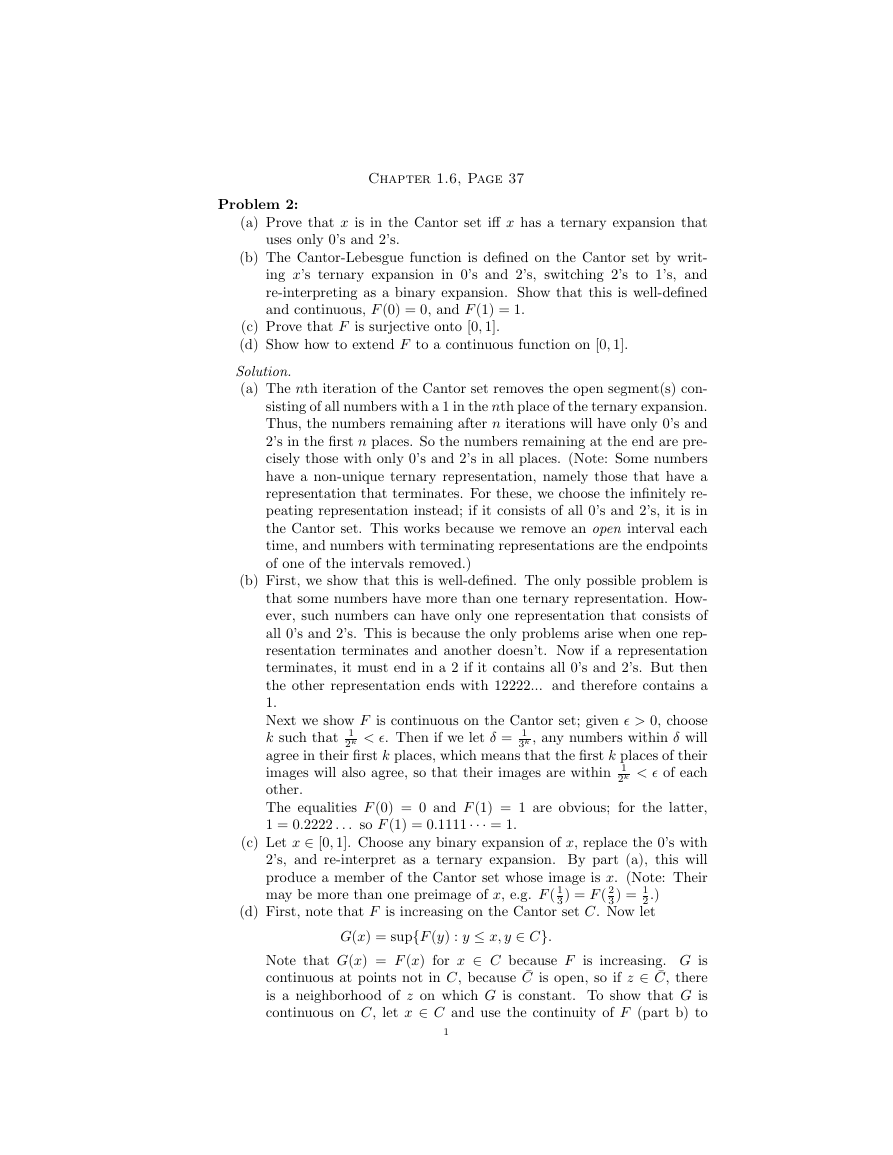
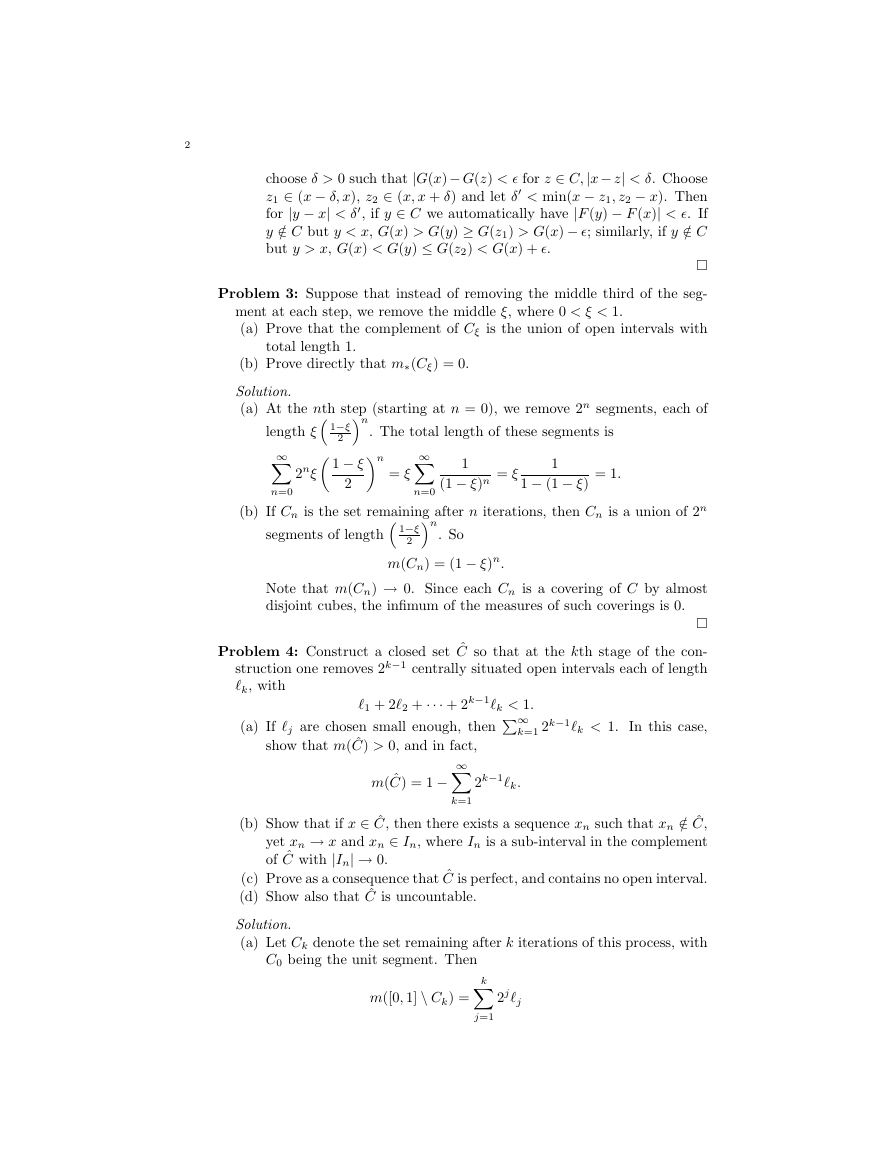

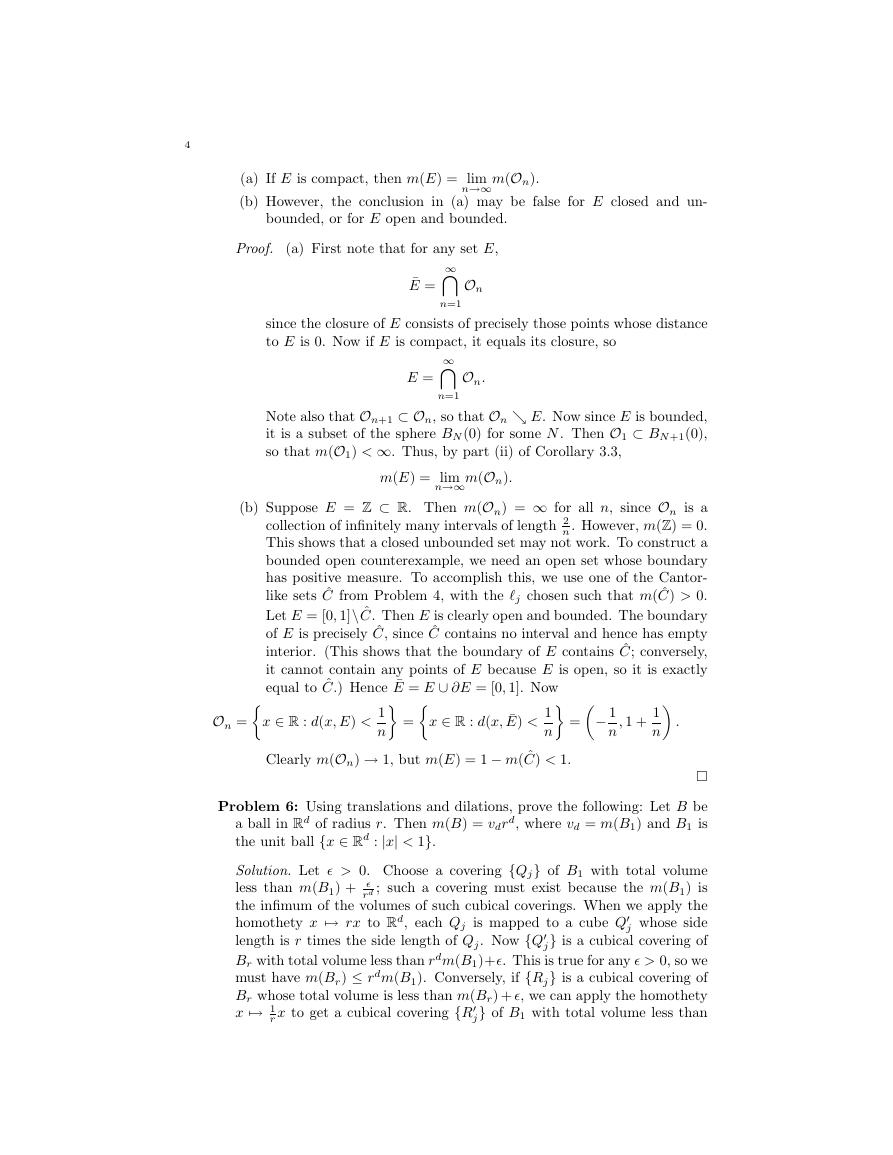
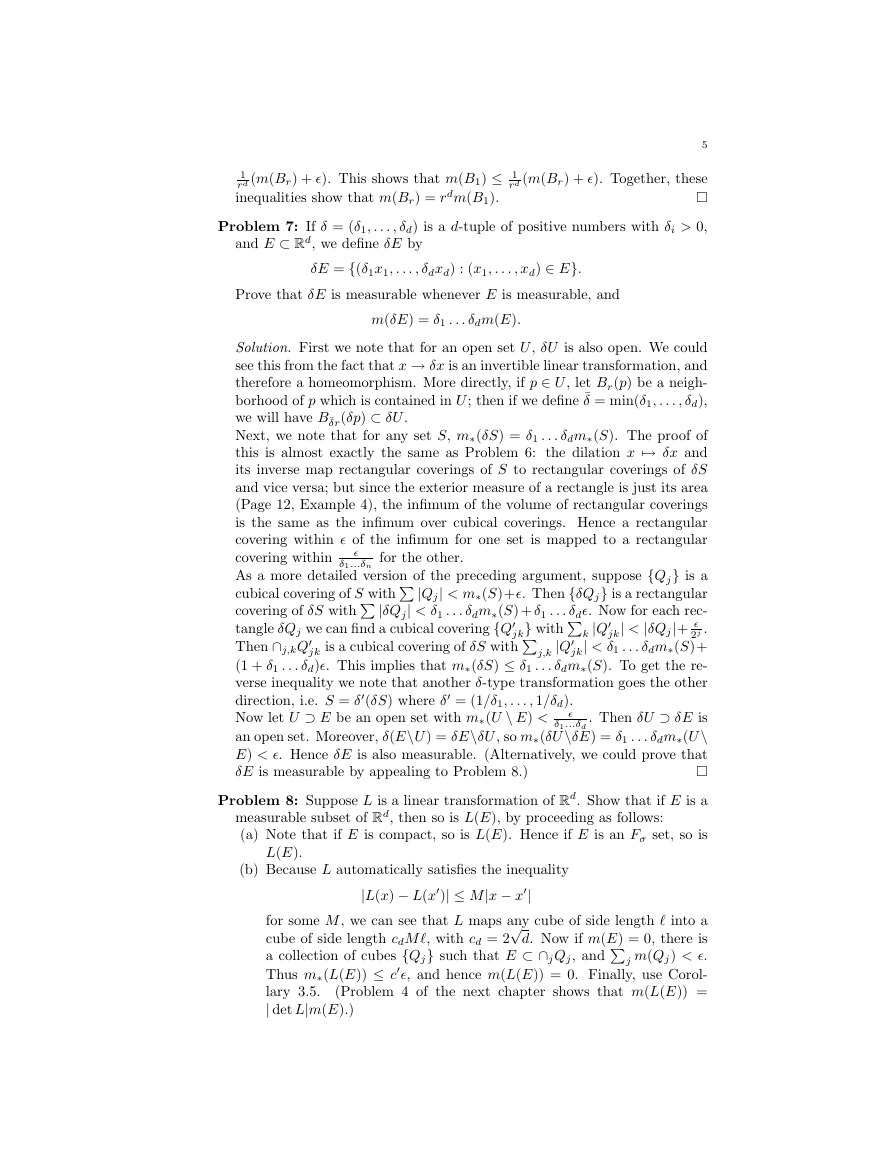
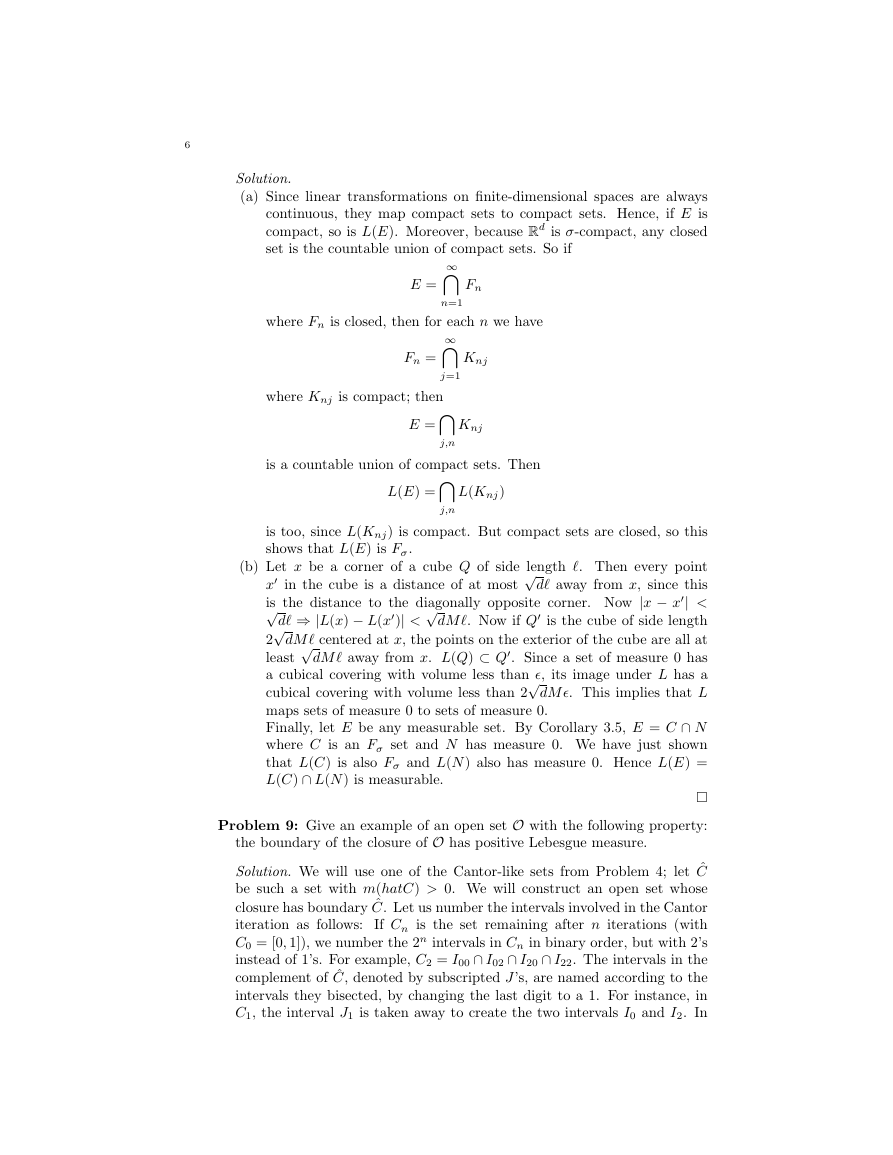
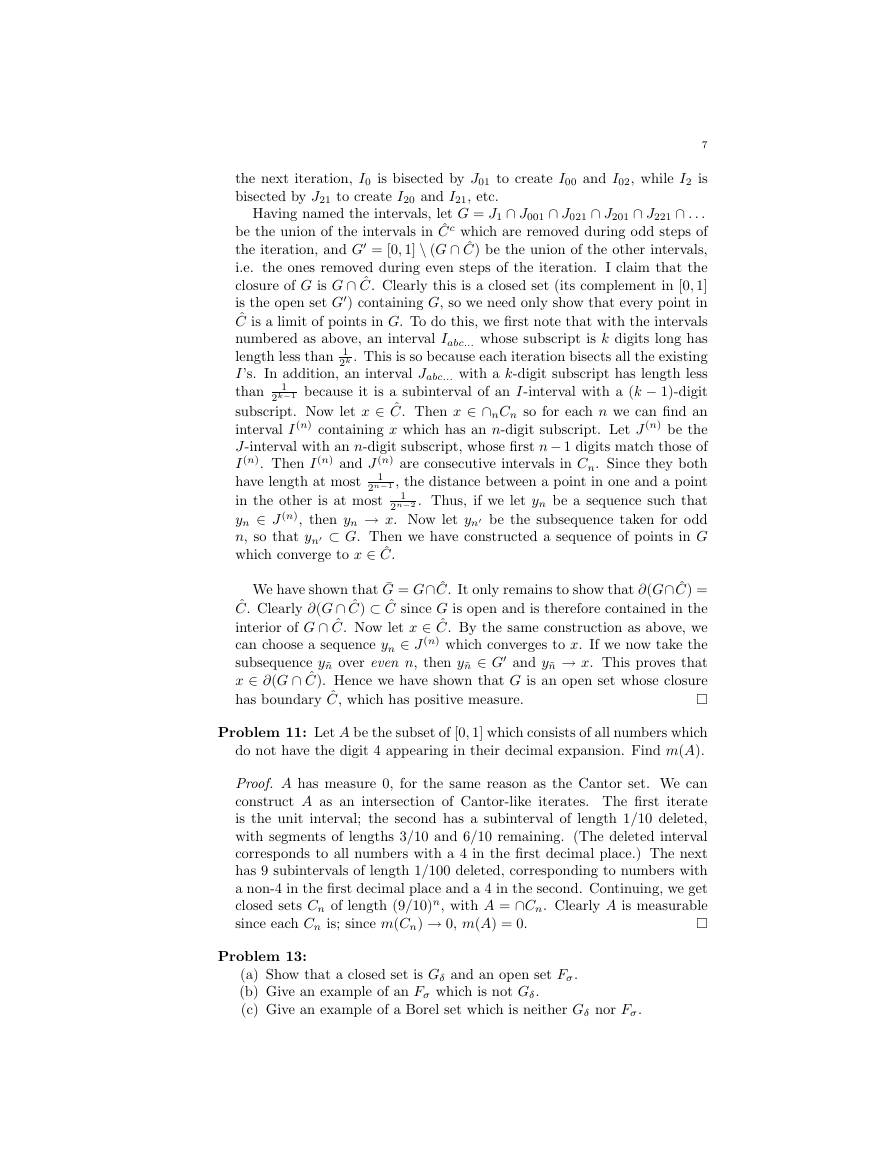
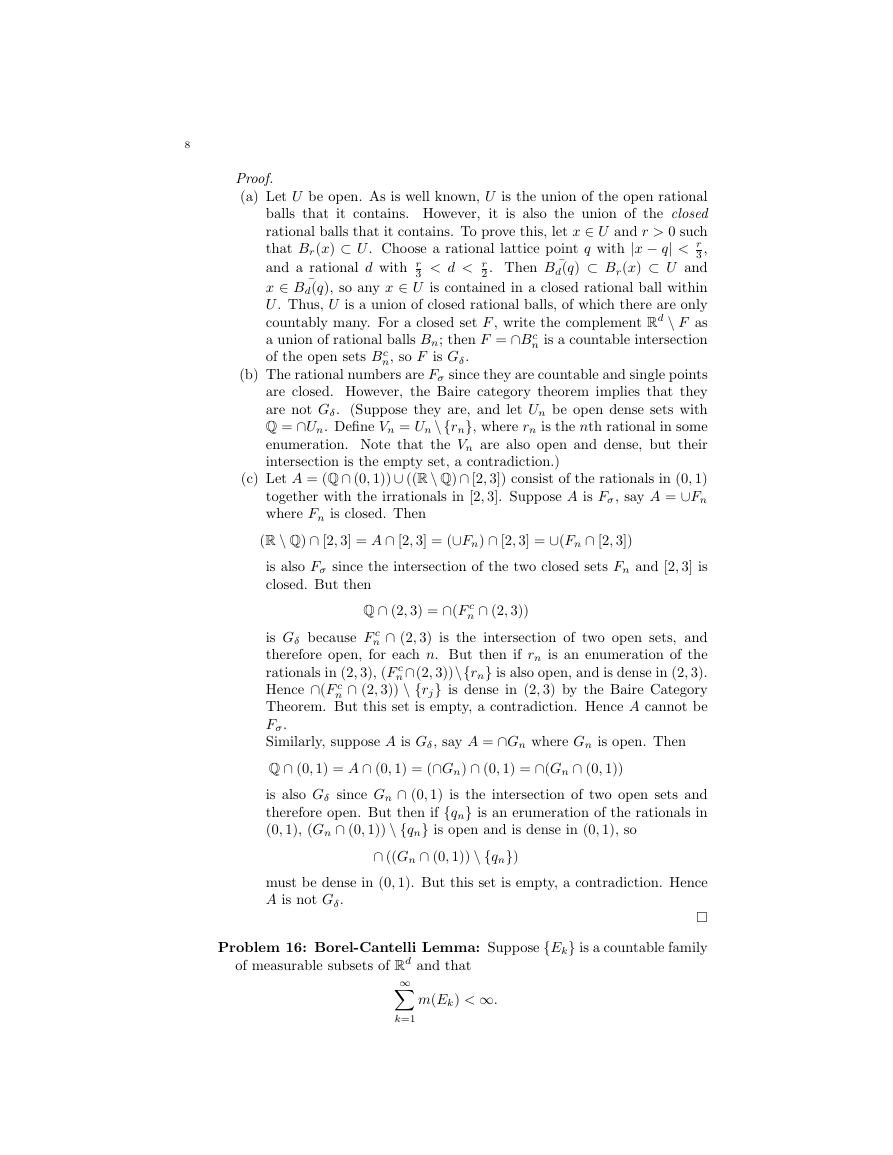








 2023年江西萍乡中考道德与法治真题及答案.doc
2023年江西萍乡中考道德与法治真题及答案.doc 2012年重庆南川中考生物真题及答案.doc
2012年重庆南川中考生物真题及答案.doc 2013年江西师范大学地理学综合及文艺理论基础考研真题.doc
2013年江西师范大学地理学综合及文艺理论基础考研真题.doc 2020年四川甘孜小升初语文真题及答案I卷.doc
2020年四川甘孜小升初语文真题及答案I卷.doc 2020年注册岩土工程师专业基础考试真题及答案.doc
2020年注册岩土工程师专业基础考试真题及答案.doc 2023-2024学年福建省厦门市九年级上学期数学月考试题及答案.doc
2023-2024学年福建省厦门市九年级上学期数学月考试题及答案.doc 2021-2022学年辽宁省沈阳市大东区九年级上学期语文期末试题及答案.doc
2021-2022学年辽宁省沈阳市大东区九年级上学期语文期末试题及答案.doc 2022-2023学年北京东城区初三第一学期物理期末试卷及答案.doc
2022-2023学年北京东城区初三第一学期物理期末试卷及答案.doc 2018上半年江西教师资格初中地理学科知识与教学能力真题及答案.doc
2018上半年江西教师资格初中地理学科知识与教学能力真题及答案.doc 2012年河北国家公务员申论考试真题及答案-省级.doc
2012年河北国家公务员申论考试真题及答案-省级.doc 2020-2021学年江苏省扬州市江都区邵樊片九年级上学期数学第一次质量检测试题及答案.doc
2020-2021学年江苏省扬州市江都区邵樊片九年级上学期数学第一次质量检测试题及答案.doc 2022下半年黑龙江教师资格证中学综合素质真题及答案.doc
2022下半年黑龙江教师资格证中学综合素质真题及答案.doc